 W
WMatch grade frequently refers to quality firearm parts and ammunition that are suitable for a competitive match. Sometimes it also refers to other devices and parts that are made with high precision in mind.
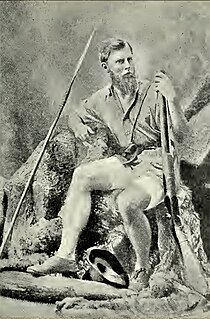 W
WFour bore or 4 bore is an almost obsolete black powder caliber of the 19th century, used for the hunting of large and potentially dangerous game animals. The specifications place this caliber between the larger two bore and the lesser six bore. This caliber was the quintessential elephant gun caliber of the black powder safari rifles. The caliber was also used for the Coffman cartridges used for starting large aero engines such as the Rolls-Royce Griffon as used in the later Marks of Supermarine Spitfire.
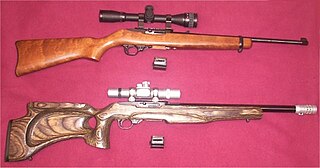 W
WAccurizing is the process of improving the accuracy and precision of a gun.
 W
WBlow-forward is a firearm action where the propellant gas pressure and the friction of the bullet traveling down the bore drag the whole gun barrel forward to facilitate the opening of the breech. This forward barrel motion provides most of the energy required to eject a spent cartridge case and chamber a fresh round of ammunition, and contains a minimum of moving parts and thus more compact than other operating mechanism of equal barrel length.
 W
WA breech-loading swivel gun was a particular type of swivel gun and a small breech-loading cannon invented in the 14th century. It was equipped with a swivel for easy rotation and was loaded by inserting a mug-shaped device called a chamber or breech block, filled with gunpowder and projectiles. It had a high rate of fire, as several chambers could be prepared in advance and quickly fired in succession and was especially effective in anti-personnel roles. It was used for centuries by many countries of Europe, Asia and Africa.
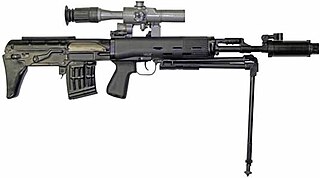 W
WA bullpup firearm is one with its action behind the trigger. This creates an overall more compact and maneuverable weapon in comparison to conventional firearm designs with the same barrel length, and maintains advantages of a long barrel such as better muzzle velocity and accuracy while reducing the overall size and weight.
 W
WIn firearms, a choke is a tapered constriction of a gun barrel at the muzzle end. Chokes are most commonly seen on shotguns, but are also used on some rifles, pistols, or even airguns. Notably, some .22 LR match rifles have a constricted bore diameter near the muzzle.
 W
WA contact shot is defined as a gunshot wound incurred while the muzzle of the firearm is in direct contact with the body at the moment of discharge. Contact shots are often the result of close range gunfights, suicide, or execution.
 W
WDry firing is the practice of simulating the discharge of a firearm without any live ammunition, or practicing with an inert laser/infrared training platform and may also include the use of a target/feedback system. The terms also commonly refers to simply "firing" a gun that has no ammunition in it. Concern is commonly expressed that doing so might damage the gun.
 W
WField stripping is firearms terminology for the act of disassembling a firearm to the greatest possible extent without the usage of any extra tools. A disassembly that uses such tools is called a detail strip, but this is less common than a field strip, as the latter is usually sufficient for most cases.
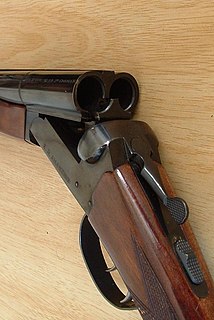 W
WIn firearms terminology, an action is the functional mechanism of a breech-loading firearm that handles the ammunition cartridges, or the method by which that mechanism works. Actions are technically not present on muzzleloaders, as all those are single-shot firearms with a closed off breech with the powder and projectile manually loaded from the muzzle. Instead, the muzzleloader ignition mechanism is referred to as the lock.
 W
WFirearm modification is commonly done in order to enhance various aspects of the performance of a firearm. Reasons for these modifications can range from cosmetic to functional, and can be simple operations that the owner can perform, or complex operations requiring the services of a gunsmith.
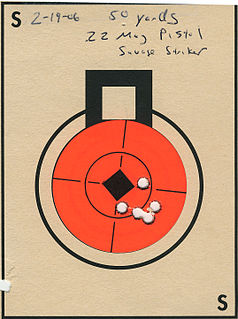 W
WIn shooting sports, a shot grouping, or simply group, is the collective pattern of projectile impacts on a target from multiple consecutive shots taken in one shooting session. The tightness of the grouping is a measure of the precision of a weapon, and a measure of the shooter's consistency and skill. On the other hand, the grouping displacement is a measure of accuracy.
 W
WThe garrucha is a small pistol, similar to a derringer, common in southern Brazil and Argentina in the early 20th century. It is usually double-barreled, though with the barrels side-by-side rather than vertical as is common in American derringers, and the bores can be rifled or smooth.
 W
WA gas check is a gasket type component of firearms ammunition. Gas checks are used when non-jacketed bullets are used in high pressure cartridges. The use of a gas check inhibits the buildup of lead in the barrel and improves accuracy.
 W
WA ballistic chronograph or gun chronograph is a measuring instrument used to measure the velocity of a projectile in flight, typically fired from a gun.
 W
WA gun serial number is a unique identifier assigned to a singular firearm.
 W
WHalf-cock is when the position of the hammer of a firearm is partially—but not completely—cocked. Many firearms, particularly older firearms, had a notch cut into the hammer allowing half-cock, as this position would neither allow the gun to fire nor permit the hammer-mounted firing pin to rest on a live percussion cap or cartridge. The purpose of the half-cock position has variously been used either for loading a firearm, as a safety mechanism, or for both reasons. The still commonly used English expression of "going off half-cocked" derives from failing to complete the cocking action, leading to the weapon being unable to fire. This is often used to describe someone acting prematurely, as in the case of one preparing to shoot their weapon without having set the firearm into "full-cock" position.
 W
WHang fire refers to an unexpected delay between the triggering of a firearm and the ignition of the propellant. This failure was common in firearm actions that relied on open primer pans, due to the poor or inconsistent quality of the powder. Modern firearms are susceptible also. The delay is usually too brief to be noticed, but can be several seconds. A hangfire should be suspected whenever a firearm fails to fire, but has not clearly malfunctioned.
 W
WFirearm magazines are used "jungle style" if they are fixed together side by side, often with tape. The spare magazine may be pointing downwards in relation to the one fitted to the weapon.
 W
WA laser sight is a device attached or integral to a firearm to aid target acquisition. Unlike optical and iron sights where the user looks through the device to aim at the target, laser sights project a beam onto the target that provides a visual reference point. Although lasers in the visible part of the spectrum are most common, invisible IR lasers may be used in conjunction with a night vision device. As they are offset from the barrel, laser sights need to be zeroed in, much like a conventional sight, so that the beam intercepts the point of impact at a chosen distance. Devices may include one or both types of laser, with some models also incorporating a rangefinder, flashlight, or IR illuminator. Laser sights may be attached to the existing sighting mechanism, the trigger guard, via a rail system, or can be integrated into replacement components such as the guide rod or grip plates. Some variants are also incorporated into other attachments such as foregrips.
 W
WLocked breech is the design of a breech-reloading firearm's action. This is important in understanding how a self-reloading firearm works. In the simplest terms, the locked breech is one way to slow down the opening of the breech of a self-reloading firearm when fired. The source of power for the movement is recoil.
 W
WA long gun is a category of firearms with longer barrels than most other types. In small arms, a long gun is generally designed to be held by both hands and braced against the shoulder, in contrast to a handgun, which can be fired being held with a single hand. In the context of cannons and mounted firearms, an artillery long gun would be contrasted with a howitzer or carronade.
 W
WLupara is an Italian word used to refer to a sawn-off shotgun of the break-open type. It is traditionally associated with La Cosa Nostra, the Italian organized crime group dominant in Sicily for their use of it in vendettas, defense —such as its use against Benito Mussolini's army when he decided to break up the Sicilian mafioso network—and hunting.
 W
WThe Maynard tape primer was a system designed by Edward Maynard to allow for more rapid reloading of muskets.
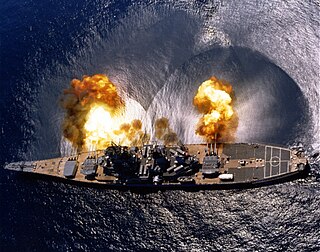 W
WA muzzle blast is an explosive shockwave created at the muzzle of a firearm during shooting. Before a projectile leaves the gun barrel, it obturates the bore and "plugs up" the pressurized gaseous products of the propellant combustion behind it, essentially containing the gases within a closed system as a neutral element in the overall momentum of the system's physics. However, when the projectile exits the barrel, this functional seal is removed and the highly energetic bore gases are suddenly free to exit the muzzle and rapidly expand in the form of a supersonic shockwave, thus creating the muzzle blast.
 W
WMuzzle flash is the light — both visible and infrared — created by a muzzle blast, which is caused by the sudden release and expansion of high-temperature, high-pressure gases from the muzzle of a firearm during shooting. Both the blast and flash are products of the exothermic combustion of the propellant (gunpowder), and any remaining unburned powders reacting with ambient air. The size and shape of the muzzle flash is dependent on the combustion energy of propellant being used, the amount of combustible ejecta remaining, and any devices attached to the muzzle.
 W
WMuzzle rise, muzzle flip or muzzle climb refer to the tendency of a firearm's or airgun's muzzle to rise up after firing. It more specifically refers to the seemingly unpredictable "jump" of the firearm's muzzle, caused by combined recoil from multiple shots being fired in quick succession. It has an adverse effect on maintaining accuracy with using automatic weapons or rapid-firing semi-automatic firearms, as a moving muzzle can throw off the shooter's aim, causing subsequent shots to miss the intended target.
 W
WA patch box is a patch storage compartment on muzzleloader guns, usually built into the stock or butt of a rifle. Patches were used to wrap a round shot lead ball projectile so that it fit snuggly in the muzzle of the gun creating the necessary seal. It also allowed undersized balls to be used. Patches were usually pre-cut and pre-lubricated, with grease, tallow, or something similar, so they were ready when needed. The patch box kept the patches handy for loading. The lubricant allowed relatively easy and rapid ramming of the ball into the muzzle, while still transferring the twist from the rifling to the projectile. The patch would generally fall away within feet of the muzzle after firing.
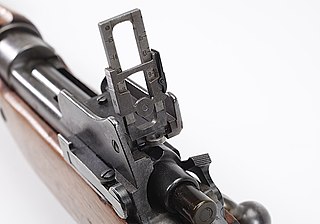 W
WPoint-blank range is any distance over which a certain firearm can hit a target without the need to compensate for bullet drop. Like any object in flight, a bullet is pulled downwards by gravity, so for distant targets, the shooter must point the firearm above the target to compensate. Otherwise, the bullet will hit the ground in front of the target. But if the target is close enough, bullet drop will be negligible so the shooter can aim the gun straight at the target. Point-blank range will vary by a weapon's external ballistics characteristics and the size of the target; the flatter the bullet's trajectory or the larger the target, the longer the point-blank range will be.
 W
WThe prangi, paranki, piranki, pirangi, farangi, firingi, or firingiha was a type of cannon produced by Ottoman Empire. It was subsequently copied and produced in other place such as by Mughal empire under Babur. Prangi was a breech-loading swivel gun.
 W
WIn breechloading firearms, primary extraction is the initial phase of the extraction of a spent casing from the firearm chamber. After the primary extraction comes the secondary extraction where the bolt is moved further backwards, and the extraction is then normally finished with the spent cartridge being ejected.
 W
WRecoil is the rearward thrust generated when a gun is being discharged. In technical terms, the recoil is a result of conservation of momentum, as according to Newton's third law the force required to accelerate something will evoke an equal but opposite reactional force, which means the forward momentum gained by the projectile and exhaust gases (ejectae) will be mathematically balanced out by an equal and opposite momentum exerted back upon the gun. In hand-held small arms, the recoil momentum will be eventually transferred to the ground, but will do so through the body of the shooter hence resulting in a noticeable impulse commonly referred to as a "kick".
 W
WA sabot is a supportive device used in firearm/artillery ammunitions to fit/patch around a projectile, such as a bullet/slug or a flechette-like projectile, and keep it aligned in the center of the barrel when fired. It allows a narrower projectile with high sectional density to be fired through a barrel of much larger bore diameter with maximal accelerative transfer of kinetic energy. After leaving the muzzle, the sabot typically separates from the projectile in flight, diverting only a very small portion of the overall kinetic energy.
 W
WA semi-automatic pistol is a type of repeating single-chamber handgun (pistol) that automatically cycles its action to insert the subsequent cartridge into the chamber (self-loading), but requires manual actuation of the trigger to actually discharge the following shot. As a result, only one round of ammunition is fired each time the trigger is pulled, as the pistol's fire control group disconnects the trigger mechanism from the firing pin/striker until the trigger has been released and reset.
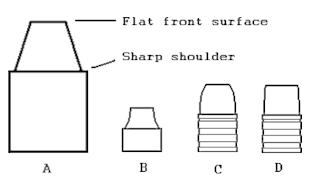 W
WA semiwadcutter (SWC) or flat-nose is a type of all-purpose bullet commonly used in revolvers. The SWC combines features of the traditional round-nosed bullets and the wadcutter bullets used in target shooting, and is used in both revolver and Rifle cartridges for hunting, target shooting and plinking. Full wadcutters frequently have problems feeding from magazines reliably in semi-automatics, so SWCs may be used when a true WC is desired but cannot be used for this reason.
 W
WA shot timer is a shot activated timer used in shooting sports, which starts the competitor by an audible signal and also records the competitor's time electronically by detecting the sound of each shot together with the time from the start signal. When the competitor is finished the timer will show the time from the start signal until the last shot. The time is usually recorded to hundredths of a second (centisecond), which is required by competitions in the International Practical Shooting Confederation.
 W
WSighting in or zeroing a firearm is the goal of adjusting the sights so the projectile may be placed at a predictable impact position within the sight picture. The principle is to shift the line of aim so it intersects the parabolic projectile trajectory at a designated point of reference, known as a zero, so the gun will repeatably hit where it aims at the distance of that "zero" point. The iterative procedure involves firing a group of bullets from a cool barrel, adjusting the sights to move the point of impact to the point of aim, and repeating the process until a group is centered on the point of aim.
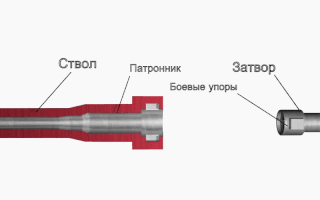 W
WA slamfire is a discharge of a firearm occurring as a cartridge is being loaded into the chamber. Some firearms are designed to slamfire, but the term also describes a malfunction of self-loading firearms. Shooters accustomed to firearms requiring trigger activation for discharge may be unprepared for a slamfire discharge.
 W
WA smoothbore weapon is one that has a barrel without rifling. Smoothbores range from handheld firearms to powerful tank guns and large artillery mortars.
 W
WA speedloader is a device used to reduce the time and effort needed to reload a firearm. Speedloaders come in a variety of forms for reloading revolvers, or the magazines used with other types of firearms.
 W
WA squib load, also known as a squib round, pop and no kick, or just a squib, is a firearm malfunction in which a fired projectile does not have enough force behind it to exit the barrel, and thus becomes stuck. This type of malfunction can be extremely dangerous, as failing to notice that the projectile has become stuck in the barrel may result in another round being fired directly into the obstructed barrel, resulting in a catastrophic failure of the weapon's structural integrity.
 W
WA wadcutter is a special-purpose flat-fronted bullet specifically designed for shooting paper targets, usually at close range and at subsonic velocities typically under approximately 900 ft/s (274 m/s). Wadcutters have also found favor for use in self-defense guns, such as .38 caliber snubnosed revolvers, where, due to short barrel lengths, maximum bullet velocities are usually low, typically under 900 ft/s (274 m/s), and improved lethality is desired. Wadcutters are often used in handgun and airgun competitions.